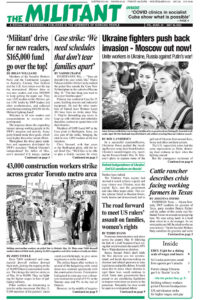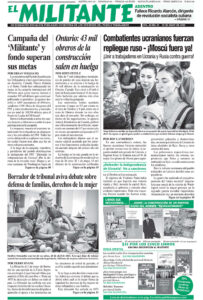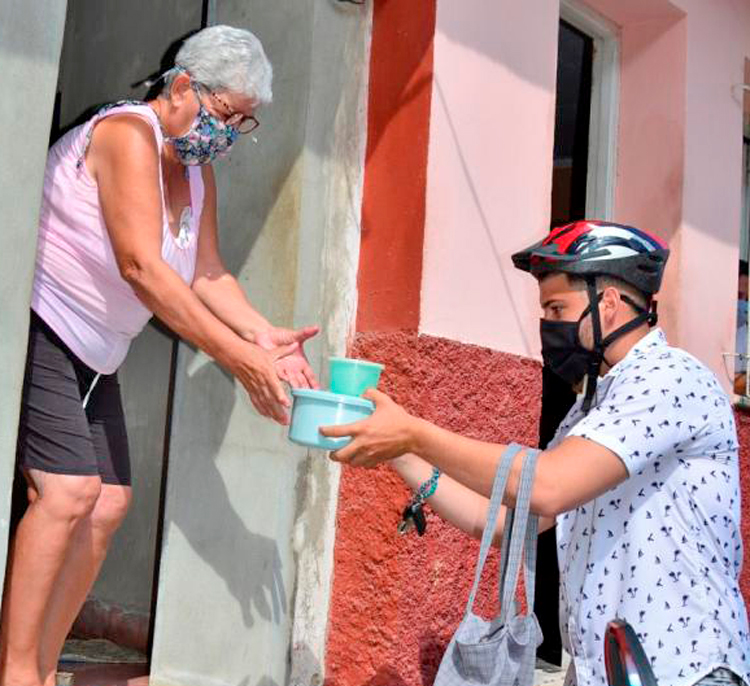HAVANA — I had been here two days in late April as part of an international team of volunteers, helping set up the Pathfinder Books stand at the Havana International Book Fair, when I developed COVID-19 symptoms.
Had I been a Cuban, I would have been seen by my family doctor and nurse, either through a house call or at their office a few blocks from my home. They would know my medical history and that of my household, and be familiar with my general living situation. As with other Cubans, my medical care wouldn’t cost me a penny.
But being a visitor from abroad, friends took me to the Cira García International Clinic. After testing positive for COVID, I was taken by ambulance to the much larger Camilo Cienfuegos International Clinic.
This clinic, a renowned ophthalmological treatment center, has been converted into a COVID isolation center for foreign visitors like me. Although it continues to serve its original function on a more limited basis, it has already housed more than 2,500 COVID patients since the start of the pandemic. The day I checked in, 27 COVID-positive adults and three children accompanied by their mothers were staying there.
My check-in was prompt, X-rays were taken and an electrocardiogram performed to assess lungs and heart, and I was assigned a simple, spotless room with a private bathroom. My expenses there were entirely covered by health insurance included in the price of my airline ticket to Cuba with an extra fee of $3 a day. All I was asked for by clinic workers was my passport, boarding pass and proof of return ticket.
I remained in isolation for 13 days. Unfortunately, I missed the entire book fair. Fortunately, I was well cared for and I learned a lot, including much of the information in this article.
Twice daily a nurse checked my vital signs, and I had two daily visits by the physician on duty. I was served three simple, well-balanced meals daily.
After 10 days of testing, my doctors determined that my antigen levels were not rising enough to fight the infection, and prescribed Nasalferon, a low-dose form of interferon administered as nose drops. Interferon has been used in Cuba as an antiviral drug since it was first developed here in the early 1980s.
During the early stages of the pandemic in Cuba, before vaccines became available, Nasalferon was widely administered to COVID patients. Now it is only given to high-risk patients or those whose immune system reacts slowly to overcome the infection.
On day 13, I finally tested negative for COVID and was released. My nurses and doctors gave me an affectionate farewell.
The health workers I got to know at the clinic were proud of their role in helping combat the pandemic. They were proud that Cuba has created effective COVID vaccines, and that brigades of Cuban medical volunteers have helped fight the pandemic in other countries. Today some 90% of Cuba’s population, including children 2 years and older, are fully vaccinated, and over 50% are boosted.
At the same time, the country’s health care system is sharply strained under the impact of the world capitalist crisis, compounded by Washington’s brutally tightened economic sanctions. Many basic medicines have to be imported, from painkillers to blood pressure drugs, and today are nearly impossible to find. In face of this crisis, over the past several months some Cuban medical workers have left for other countries.
How Cubans fought COVID
For the first year of the pandemic, a well-organized system of contact tracing and quarantine centers, and visits to the homes of people for whom it was harder to get around, together with other public health measures, helped slow down the spread of the virus. The sharp surge in infections in mid-2021 receded once vaccines were rolled out, and the country was able to lift many restrictions by the end of last year. As of May 15, only two COVID deaths had been reported in two weeks.
Because of the enormous costs involved in maintaining the quarantine centers — from food, air conditioning and supplies to workers’ wages — today only young children (with their mothers), the elderly and people with potential medical complications are isolated in medical facilities. Most COVID patients and their contacts quarantine at home.
I called Moraima López MacBean, a leader of the Paulo Freire Community Center in La Lisa, a large working-class district of Havana. She told me the neighborhood-based Committees for the Defense of the Revolution (CDRs) have helped organize to bring food to those isolating at home, especially those living alone or with disabilities.
Nonetheless, the forced social isolation over two years of the pandemic has taken a toll, especially among the elderly. With a life expectancy comparable to the most developed imperialist countries, Cuba has the oldest population in the Americas, and more older Cubans are living alone than ever before.
López MacBean noted the many initiatives in Cuba to draw older adults into social and productive activity. These include the Casas del Abuelo (Grandparents’ Circles), day care centers for the elderly; the University for Older Adults, for continuing education; and the tai chi exercise sessions held in neighborhoods across Cuba. Under the pandemic protocols, these programs were largely suspended.
“For me, the hardest was the end of the daily tai chi exercises,” said María Eugenia Quintana, 86, a resident of La Lisa and leader of the University for Older Adults.
The prolonged social isolation has had an impact on mental health for many older Cubans. Yudeysi Aguilar, a nurse at the Camilo Cienfuegos Clinic, told me she has seen a greater demand for geriatric and mental services at Havana clinics.
The health care workers who took care of me were particularly interested to hear about the situation in the United States. Jesús, a nurse, was surprised when I described how working people in the U.S., where the medical system is a for-profit capitalist business, with sharp class differences in how they and their bosses are treated, have been left to fend for themselves in face of the pandemic.
Some I spoke with have had firsthand experience with the conditions working people face under capitalism. Dr. Silvio Saya, an anesthesiologist in his 30s, served for three years on an internationalist medical mission in a village in southern Bolivia. “It was disturbing for me to have to charge patients for surgery or tests,” he said about the clinic where he worked.
“I loved the work I did and learned a lot. But I never got used to it. I grew up instilled with socialist values, not capitalist ones.” Those values are the product of a socialist revolution, through which Cuba’s working people overturned capitalist rule, took state power, and for more than six decades have fought to transform society.
Before my release, I gave Dr. Saya a copy of Red Zone, by Cuban journalist Enrique Ubieta, one of the most popular books at the Pathfinder stand during the book fair. It’s an eyewitness account of how Cuban internationalist medical volunteers and their revolutionary government were decisive in ending the 2014–15 Ebola epidemic in West Africa. He was delighted.


